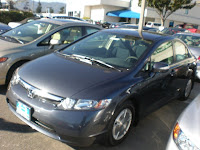
Kate Taylor
Truth Esguerra
Ekaterine Basilaia
The Hybrid Trend
Jeff Molumby, a business owner in San Francisco, is the owner of a Toyota Prius.
He said he bought the car in 2006 for $29,000 because his commute to and from work was about 60 miles each way and he wanted the financial benefits offered with the car.
“I get to drive in the carpool lane, which is nice,” Molumby said. “There was a tax credit, which was pretty big. I think it was about three grand.”
His Prius gets about 45 miles per gallon and has around 90 horsepower, he said, which caters to his freeway and city-driving needs.
“I don’t really need to go from zero to 60 (mph) in four seconds,” he said. “I don’t ever go past 90 (mph), so it goes as fast as I need it to go.”
Molumby is a part of the “green” trend that has risen in popularity in the last six years.
****
“Going green” means practicing more environmentally friendly behaviors, whether it’s recycling, cutting down on pollution or saving energy.
Low-, ultra low- and partial zero-emission vehicles with hybrid engine systems have recently become a trend among car buyers, according to an article by Jason Moore titled “Fuel-Efficient Ford Cars: The New Trend,” published on Buzzle.com.
According to the California vehicle emissions ratings, low-emissions vehicles are the emission standard for all cars sold in the state starting in 2004.
The emissions ratings stated that ultra low-emissions means the vehicles produce 50 percent less pollutants than regular models, and partial zero-emissions are 90 percent cleaner than regular models.
The hybrid engine system refers to any vehicle that combines a gas engine and electric motor and battery, said Jim Kaefer, sales manager at Capitol Toyota in San Jose.
The vehicle does not need to be charged, he said, and the battery is disposable and “not hazardous to the environment.”
Hybrid technology allows the driver the option to create the power, said Luart Tobias, a sales consultant for the Capitol Honda dealership.
Honda has been making hybrid vehicles since 1999, starting with the Honda Insight, Tobias said.
When Honda’s hybrid system car first came out, he said, the dealership would only keep about one or two of them on the lot.
Now, Tobias said, there are usually about 20 hybrids on the lot at one time.
Since 2005, national Civic Hybrid sales have risen slightly by percentage, from 8.3 percent of all Civic sales in 2005 to 11.9 percent so far this year, he said.
“I get a lot of people who are fuel conscious,” Tobias said. “There’s some people who like it just because it’s technology, and obviously, the main reason is the gas savings.”
Sales percentages for the Prius were unavailable.
“The fact that gas is going up close to $4 is helping the Hybrid sales a lot,” Tobias said.
Tax credits were given out for both the Prius and Civic Hybrid as incentives to prospective buyers.
Credits for the Civic Hybrid are currently $1,080, until July, Tobias said, when they will drop to $525.
In April 2007, tax credits for Prius ended, Kaefer said.
“They had the (carpool) stickers back in 2006,” Tobias said.
He said the State of California offered stickers for cars with hybrid systems allowing owners to drive their vehicles in the carpool lane without having a person in the passenger seat, and free parking in public garages.
“The free parking downtown still exists,” Tobias said, “but the carpool stickers (were) … only for a certain amount of vehicles and they stopped after they created enough.”
According to their dealerships, both vehicles get about 45 miles per gallon of gas and cost anywhere from $23,000 to $29,000.
Both Kaefer and Tobias said any wrecked hybrid vehicle could be taken to any body shop unless the actual hybrid system is impaired.
“If the hybrid system was damaged, that would have to come back to the dealer,” Kaefer said.
He also said Toyota has been talking about improving all of their current models, and coming out with a vehicle that uses even less gasoline than the Prius.
“Toyota is hoping to have a hybrid option for every model down the road,” he said.
Currently, about 90 percent of Toyota’s vehicles are partial zero-emissions vehicles, he said.
Tobias said Honda believes zero-emissions vehicles, or ZEMs, are the future of cars.
“What Honda’s doing is, by next year, they will be releasing a newer, cost-effective hybrid,” he said. “They have a concept car … it’s going to be upgraded technology compared to what we have in 2006.”
Tobias said he considers lower-emission engine technology a trend, and expects to see more ZEMs on the road in five to ten years.
***
The engineering department at SJSU is also “going green.”
Tai-Ran Hsu, a professor of engineering, and his engineering students have been building a ZEM since 2006 and its completion is scheduled for April.
The ZEM’s power sources are solar panels and a chargeable battery, Hsu said, so the car does not require any gasoline fuel at all.
He said although the maximum speed of the car is 40 mph, the cost of production for the ZEM is between $3,000 and $4,000.
“The cost of a Prius is $20,000,” Hsu said. “We’re talking about only a fraction of that.”
Video
Pictures





No comments:
Post a Comment